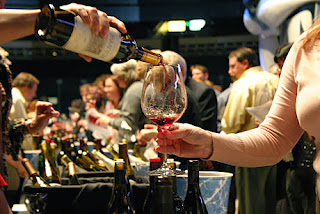The Cape wine growing areas, produce some of the world's most outstanding wines. Production of wine brings an important contribution to the South African economy. It is estimated that a growing figure of about one billion liters of wine are produced every year.
Take a look at an OVERVIEW and learn more about the current state of the industry
Take a look at an OVERVIEW and learn more about the current state of the industry
SOME HISTORY
Jan van Riebeeck, the first governor of the Cape, planted a vineyard in 1655, and on 2 February 1659, the first wine was made from Cape grapes. This led to the planting of vines on a larger scale at Roschheuvel, known today as Bishopscourt, Wynberg. Van Riebeeck strongly encouraged farmers to plant vineyards although initially they were most reluctant. He planted a vineyard on his farm Constantia and made good wine from the outset. Later, Constantia was acquired by the Cloete family and their wines became world-famous. To this day, Constantia wine is mentioned when the world's finest examples are discussed.
South African wines versus the World
Do South African wines hold their own in world markets? Yes, with certain provisos. Firstly, they have a narrower product demand in many world markets and where they do have them it is not a pretty story, except perhaps for a few niche wines. Generally, SA wines provide easy drinking in big red styles in most of its markets. South African wines are in growing demand overseas and more than 2 million cartons are reported to be exported per year.
Most of the cellars can be visited without special arrangement and some of them have also extra facilities as restaurant or even accommodation.
The viticulture in the Cape Peninsula can be traced to the 17th century. Dutch and especially French settlers brought the know-how and rapidly had excellent results in the sunny and fertile valleys around Stellenbosch, Paarl and Franschhoek.
Today the wine production produces also good wines from further areas as the Breede River, the Overberg, the Swartland and the Cedarberg.
While having a BREATHTAKING Wine Tasting Experience enjoy....
Most of the cellars can be visited without special arrangement and some of them have also extra facilities as restaurant or even accommodation.
The viticulture in the Cape Peninsula can be traced to the 17th century. Dutch and especially French settlers brought the know-how and rapidly had excellent results in the sunny and fertile valleys around Stellenbosch, Paarl and Franschhoek.
Today the wine production produces also good wines from further areas as the Breede River, the Overberg, the Swartland and the Cedarberg.
While having a BREATHTAKING Wine Tasting Experience enjoy....
South Africa's coastal playground
This is a landscape of tall trees, curving coastline, mountain hideaways, artist communities and modern malls. The trick with travelling along the Garden Route is to have enough time to keep slipping off the N2 onto the side-roads with promising destinations.
The Garden Route is a mix of modern golf courses, ancient forests, secluded artist communities, retirement estates, modern malls, craft centres, mountain hideaways and beach holidays. A large number of interesting and creative people have come to live down here, drawn to this magnificent stretch of coastline. The main arterial highway of the Garden Route in South Africa - a highlight on most visitors' itineraries - is the N2 stretch running from Heidelberg in the southern Cape to Storms River Village on the Eastern Cape border.
While the Garden Route road is extremely scenic, it is the hidden destinations on its side roads that are the secret of this region.
Big 5 safaris
Be exhilarated, awed and maybe even terrified...Coming face-to-face with the Big 5 is an experience of a lifetime. You've read the books, seen the movies and TV programmes, now encounter the famous Big 5 face-to-face - buffalo, elephant, lion, leopard and rhino.
Big 5 safaris in South Africa are a must-do for anyone fascinated by wildlife. Big 5 refers to buffalo, elephant, ion, leopard and rhino – the term comes from the animals considered most dangerous to hunt. Now the thrill comes from photographing them in their natural habitat.
African-inspired treatments
Spoil yourself with an African-inspired spa treatment
Since the beginning of time, African people have looked for inspiration and healing from Mother Earth, so why not take that same enlightened concept into the modern-day spa?
African-inspired treatments are all the rage at various spas throughout the country. Instead of looking to other continents for inspiration our local spas have done some soul-searching and have come up with a range of unique treats and treatments inspired by the sacred knowledge found in our own backyard. African-inspired treatments are a treat for mind, body and soul
Since the beginning of time, African people have looked for inspiration and healing from Mother Earth, so why not take that same enlightened concept into the modern-day spa?
African-inspired treatments are all the rage at various spas throughout the country. Instead of looking to other continents for inspiration our local spas have done some soul-searching and have come up with a range of unique treats and treatments inspired by the sacred knowledge found in our own backyard. African-inspired treatments are a treat for mind, body and soul

.jpg)






No comments:
Post a Comment